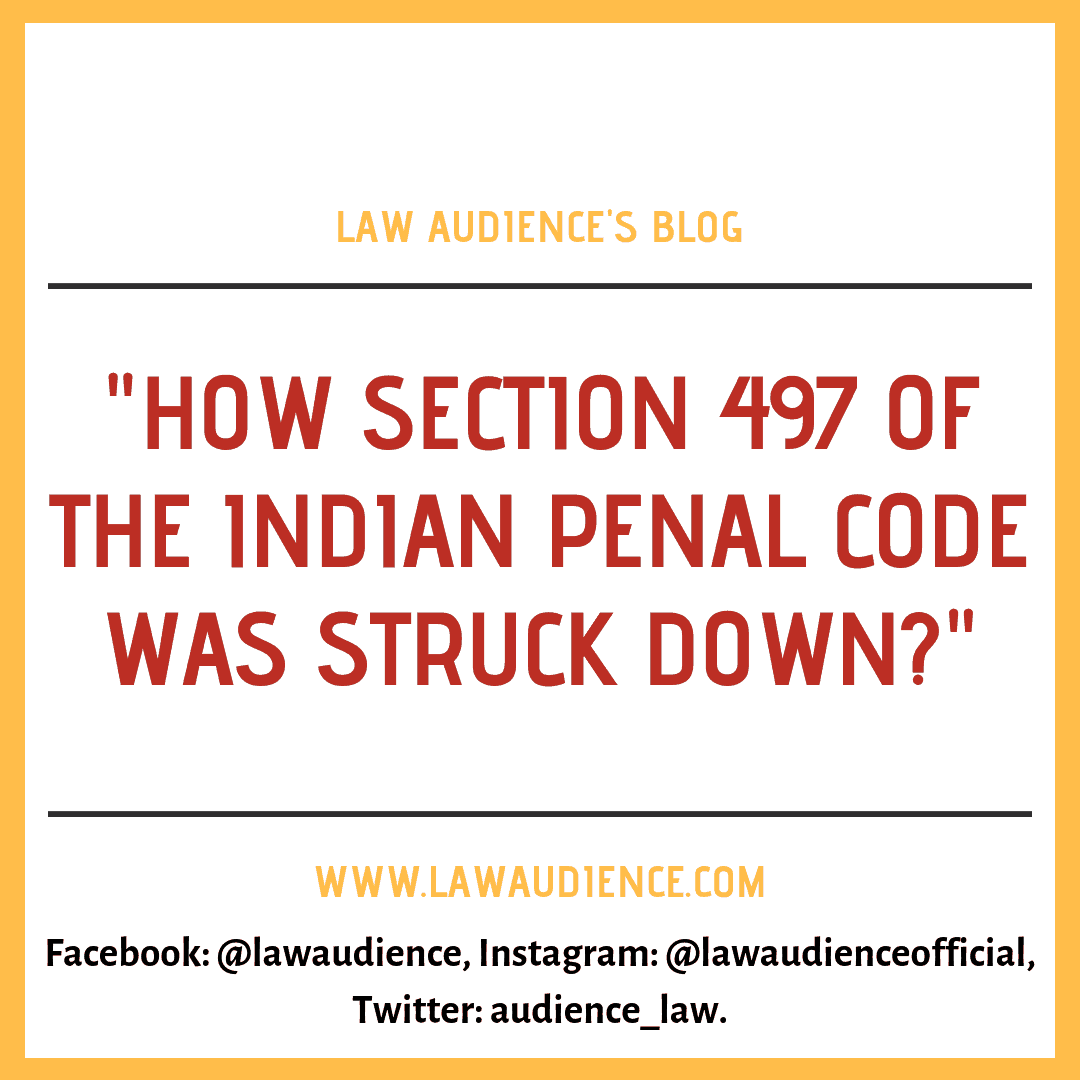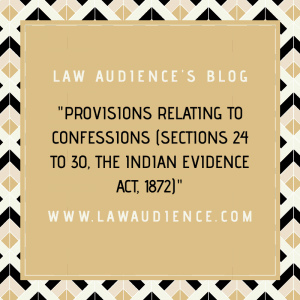AUTHORED BY: MS. NISHITA KAPOOR, B.COM.LL.B, STUDENT AT UNIVERSITY INSTITUTE OF LEGAL STUDIES, PANJAB UNIVERSITY & RESEARCH WRITER AT LAW AUDIENCE.
I. INTRODUCTION:
From the bare wording, it becomes clear that adultery means a voluntary sexual relationship between a married person and someone who is not his/her lawful spouse. It is an anti-social act and is considered to be against the tenets of every religion. The provision on adultery was provided under Section 497, Indian Penal Code, 1908. This provision was not included in the first draft of the Indian Penal Code, 1908, because Lord Macaulay believed that the inclusion of this provision would cause unnecessary interference and also that the society should itself account for it and hence it should only be treated as a civil injury. Still, it was later on incorporated under the Chapter XX of the Code, dealing with the offences relating to marriage.
It was suggested by the Law Commission of India in its Report No. 156th, Vol. 02 at Page No. 452[1], that the adultery should not be kept out of the Code but its meaning was restricted making it applicable only on men and not on women and the Law Commission of India at that time suggested the substitution of new Section 497 for Adultery which reads as follows:
“Whoever has sexual intercourse with a person who is, and whom he or she knows, or has reason to believe, to be the wife or husband, as the case may be, of another person without the consent or connivance of that other person, such sexual intercourse by the man not amounting to the offence of rape, commits adultery, and shall be punished with imprisonment of either description for a term which may extend to 5 years, or with fine, or with both.[2]”
It is also evident that adultery is not a criminal offence in other countries such as United Kingdom (but, however, it is a ground for Divorce in U.K.)[3], Malaysia, China, Japan, Brazil, Singapore and Hong Kong. But, however, it is considered as a heinous offence in Pakistan and other Islamic Countries where both man and woman are subjected to punishment.
According to Common Law, adultery is said to take place only when a woman is married and both the parties are punished.
II. SECTION 497, INDIAN PENAL CODE, 1908:
The wording of Section 497 provides that, if a person has sexual intercourse with the wife of another man with knowledge or reasons to believe that she is the wife of another man and without that person’s consent is guilty of the offence of adultery provided that it does not amount to rape. This means that if the sexual intercourse takes place without the lady’s consent that then it would not be covered under the offence of adultery but would be the offence of rape. The punishment for the offence as provided under Section 497 was imprisonment of either description for a term which may extend to five years or with fine or both[4].
It is not necessary for an offender under this section to know that whose wife is the woman with whom he had sexual intercourse, it is sufficient if he knew that she is a married woman.[5]
III. CONSTITUTIONALITY OF SECTION 497, INDIAN PENAL CODE, 1908:
The Constitutionality of adultery was for the first time challenged in the case of Yusuf Abdul Aziz v. State of Bombay[6], on the ground that as it holds only the man liable for the punishment and not the wife with whom adultery is committed, it is in violation of Article 14, 15 and 21 of the Constitution. But the Supreme Court held it to not be ultra vires the Constitution. In this case “Sex” was held to be reasonable classification, which facilitates making of special provision for women under Article 15 (3) of the Constitution.
It was again challenged in the case of Smt. Sowmithri Vishnu v. Union of India[7], on the basis that Section 497 makes an irrational classification between men and women and that it doesn’t provide the husband with the right to prosecute his wife who has committed adultery neither does it give the wife the right to prosecute her husband if he has committed adultery with any other woman (whether married or not). The Supreme Court again upheld the constitutionality of Section 497 and observed that “It is the man who is the seducer and not the woman.”
Again a constitutional gun was pointed out in the case of V. Revathi v. Union of India[8], wherein the court observed there is reverse discrimination in favour of a woman rather than against her. It would in social good for the husband and wife to make up or break up rather than dragging each other to the criminal court. Thus again, the court upheld its constitutionality validity.
IV. THE ADULTERY IS NO MORE A CRIME IN INDIA:
A writ petition was filed under Article 32 challenging the provision of Section 497 in the case of Joseph Shine v. Union of India[9], where the Supreme Court observed that:
- The judgment of Yusuf Abdul Aziz does not tune with the modern constitutional doctrine and the judgment of Sowmithri Vishnu must be said to be swept away by the recent judgments which have expanded the scope of Article 14, 15 and 21 of the Constitution. The ancient notions that “The man being the seducer and women as victim” is no longer tenable today.
- This provision of Section 497 treats women as subordinate to men as it provides that the consent of a husband would condone the act and then it would not be an offence. Thus, the women are being treated merely as chattels and the property of men.
- Section 497 is destructive and deprives a woman of her autonomy and dignity. If the object of the law is to protect the institution of marriage then there is no justification for not recognizing the agency of a woman whose spouse has committed sexual intercourse outside marriage.
- The provision of the offence is arbitrary and is not rational as no doubt it does not treat a woman as an abettor yet it does not enable a wife to file criminal prosecution against her husband. It, therefore, protects the woman on one hand and on the other hand offers no protection.
- Section 497 creates distinctions on the gender stereotypes which affects the dignity of a woman and hence offends Article 21 of the Constitution.
- It is different from the offences committed under Section 498 or under the Protection of Women from Domestic Violence, 2005, which sub-serve various purposes relating to the protection of matrimonial relation and of a married woman. Treating adultery as an offence, on the other hand, amounts to entering into the private realms and therefore adultery stands on a different footing from the above-mentioned offences as they neither enter into private realms nor involve any third party. Thus, adultery does not fit into the concept of crime.
- Section 497, IPC is unconstitutional and thus adultery should not be treated as an offence. Section 198, Code of Criminal Procedure which provides the procedure for filing the complaint in relation to adultery is also unconstitutional as the procedural provision has to follow the same path which the substantive provision follows.
V. CONCLUSION:
Adultery is a moral wrong and affects the spouse and family of a person. But yet it lacks such elements of causing wrong to the society that it should be a part of the criminal law. Most of the countries had already decriminalized adultery and it was a high time for India to do the same. Moreover, the provision of Section 497, Indian Penal Code, 1908, is very gender biased and failed to consider both sexes as equal. Hence, in such circumstances the civil remedy is sufficient.
“According to the recommendations of the National Commission for Women, adultery should be treated as a breach of trust and only a civil offence.[10]”
Hence, the Supreme Court has by the recent judgment of Joseph Shine has struck down Section 497, Indian Penal Code, 1908, and overruled all the three previous judgments where its constitutionality was challenged and upheld.
[1] The Law Commission of India, Report No. 156th, Vol. 2, on Indian Penal Code (Feb. 01, 2019, 10:00 AM) http://lawcommissionofindia.nic.in/101-169/Report156Vol2.pdf.
[2] Ibid.
[3] Get a divorce (Feb. 01, 2019, 10:25 AM) https://www.gov.uk/divorce/grounds-for-divorce.
[4] Section 497 (now it has been struck down by the Hon’ble Supreme Court of India), Indian Penal Code, 1908 (India).
[5] Madhub Chander Giri, (1873) 21 WR Con. 13 (India).
[6] 1954 Cr LJ 886 (S.C.) (India).
[7] 1985 Cr LJ 1302 (S.C.) (India).
[8] A.I.R. 1988 S.C. 835 (India).
[9] Writ Petition (Criminal) No. 194 of 2017 (India).
[10] https://www.hindustantimes.com/india/make-adultery-civil-offence-says-women-s-panel/story-NGrdaHMMq6MayH8DTcH7OI.html.



